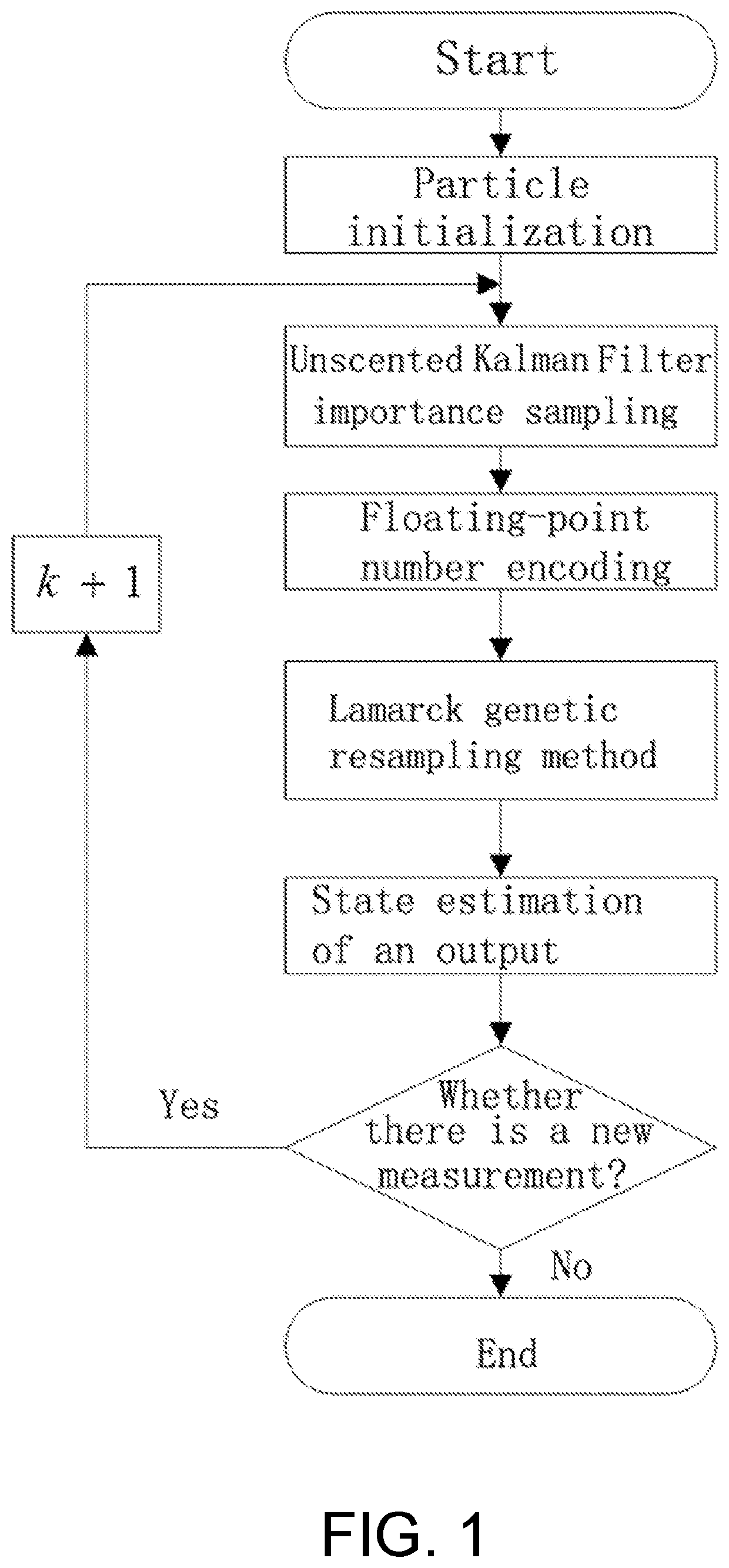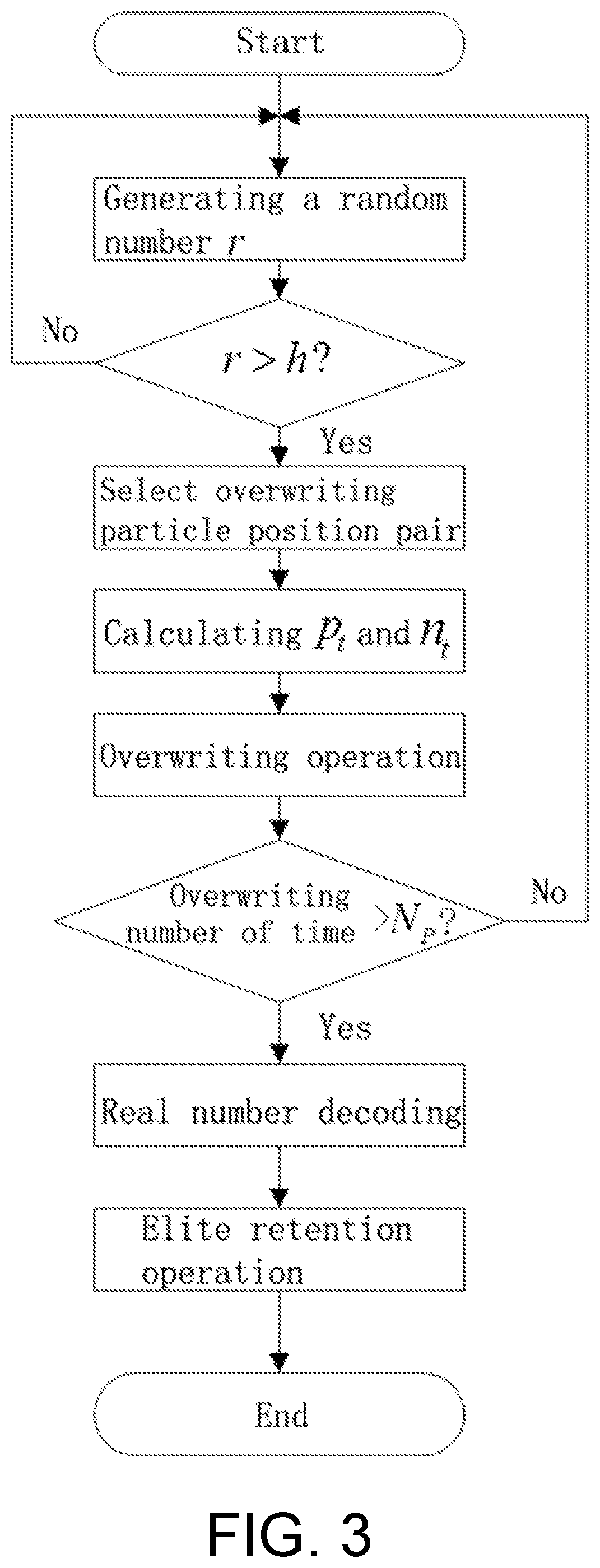Global optimal particle filtering method and global optimal particle filter
a global optimal and filtering technology, applied in the field ofsignal processing, can solve the problems of limited particle filtering algorithm performance, particle degeneration, and extended kalman filtering cannot deal with weak nonlinearity, so as to improve the particle utilization rate, improve the filtering estimation accuracy, and increase the particle diversity
- Summary
- Abstract
- Description
- Claims
- Application Information
AI Technical Summary
Benefits of technology
Problems solved by technology
Method used
Image
Examples
embodiment 1
[0035]A global optimal particle filtering method provided by the invention uses the particle to describe a state space of a dynamic system, and assumes that the state space model of the nonlinear dynamic system is:
xk=fk−1(xk−1, uk−1)
zk=hk(xk, vk)
wherein xk∈Rn is a n-dimensional system state vector at a time k, zk∈Rm is the m-dimensional measurement vector at the time k; a transition map and a measurement map of the system state are fk−1(×):Rn×Rn→Rn and hk(·):Rm×Rm→Rm respectively; a process noise and a measurement noise of the system are uk−1∈Rn and vk∈Rm respectively.
[0036]It should be noted that the representation of the state space model of the nonlinear system is equivalent to the above formula, that is, those skilled in the art can think of that the formula representation of the nonlinear system is as shown in the above formula.
[0037]Firstly, an Unscented Kalman Filter algorithm is used to generate an importance function, and it is sampled to obtain sampled particles. Then, a L...
embodiment 2
[0046]The present embodiment differs from embodiment 1 in that:
[0047]The initial particle set in step 1 is {x0i, i=1, 2, . . . , N}, characterized in that, the step 2 is specifically as follows:
[0048]Step 2.1: calculating a mean {tilde over (x)}ik and a variance Pki of the initial particle set {x0i, i=1, 2, . . . , N}, and obtaining a proposal distribution q(xki|x0:k−1i, z1;k)=N({tilde over (x)}ki, Pki) of UKF; wherein the particle xki satisfies xki˜N({tilde over (x)}ki, Pki).
[0049]Step 2.2: calculating the weight {tilde over (w)}ki of the sampled particle xki and normalizing it to obtain the normalized weight wki, i.e.,
w~ki∝w~k-1ip(zkxki)p(xkixk-1i)q(xkixk-1i,zk),wki=w~ki / ∑i=1Nw~ki.
[0050]Step 2.3: obtaining the sampled particles {xki, wki}i=1N according to the particle xki and its weight wki.
[0051]The other steps and parameters are the same as those in embodiment 1.
embodiment 3
[0052]The present embodiment differs from embodiment 1 or 2 in that:
[0053]Step 3 is specifically as follows:
[0054]Representing the particle xki as xki=(ni1ni2 . . . nil)k by the floating-point number format using a fixed number l of significant bits, and obtaining the encoded particle set {(ni1ni2 . . . nil)k}i=1N={(n11n12 . . . n1l)k, (n21n22 . . . n21)k, . . . , (nN1nN2 . . . nNl)k}, wherein nNl represents a value of a significant digit of the Nth particle.
[0055]The first bit ni1 of the floating-point number value represents the sign bit. “1” represents a positive number and “0” represents a negative number. The fixed number l of significant bits is set by the pre-filtering range. It should be noted that in maltlab it is correct to four decimal places, and if the bits is less than l, the highest bit is 0. For example, the ith particle has a state value of 15.6745 at the time k, and then its floating-point number format is as shown in FIG. 2.
[0056]The other steps and parameters are...
PUM
 Login to View More
Login to View More Abstract
Description
Claims
Application Information
 Login to View More
Login to View More - R&D
- Intellectual Property
- Life Sciences
- Materials
- Tech Scout
- Unparalleled Data Quality
- Higher Quality Content
- 60% Fewer Hallucinations
Browse by: Latest US Patents, China's latest patents, Technical Efficacy Thesaurus, Application Domain, Technology Topic, Popular Technical Reports.
© 2025 PatSnap. All rights reserved.Legal|Privacy policy|Modern Slavery Act Transparency Statement|Sitemap|About US| Contact US: help@patsnap.com



